Help my blow off valve does sound right
#1
I bought a new BOV, My old one wouldn't stay closed at idle, the new doesnt go pshhhhh, when if releases it goes ps ps ps ps .....like it is skipping. Help I have tried to adjust this thing many times also my old BOV did the same noise
#2
This should help you with your adjustments -BOV Myth #1: The adjustment screw on top of an aftermarket BOV adjusts the sound that the BOV makes.
This is the most dangerous myth of all. If you hear a different sound from adjusting this screw, it means you are getting compressor surge which could destroy your turbo.
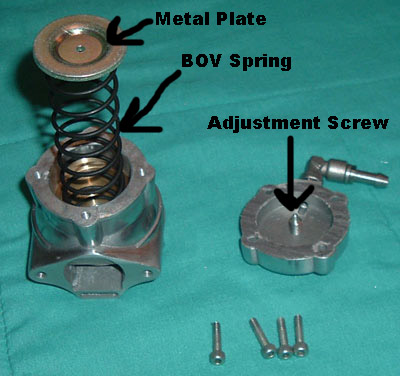
All this screw does is adjust the preload on your BOV spring. BOV's have a small metal plate on top of the spring. The screw screws directly into this plate, compressing the spring. Tightening it (turning it right/in) will compress the spring, increasing the spring energy. Loosening it (turning it left/out) will decompress the spring, lowering the spring energy. (Side note: you can achieve the exact same effect by placing washers/shims on top of the BOV spring.) As you will read below, the BOV spring should be adjusted to the lightest level possible while still holding your BOV shut during high vacuum conditions.
BOV Myth #2: The spring in a BOV holds the BOV closed during moments of high boost.
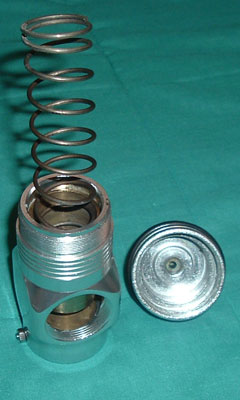
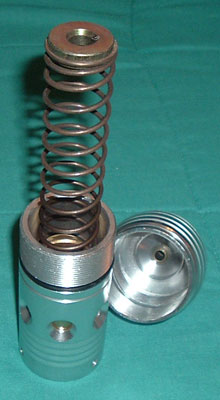
First thing is first: The purpose of the spring in a BOV IS NOT to hold your BOV closed under boost pressure! Selecting a spring based on PSI is incredibly confusing/meaningless and it makes us wonder if the people who pioneered aftermarket BOV design in the first place even understood how they work.
All BOVs have a reference line coming into the top of the BOV from your post-throttle body intake manifold. Under high boost, the force holding the BOV closed is BOOST! The pressure coming through the reference line is equal to the pressure under the BOV piston. Therefore a VERY mild spring will hold it shut just fine under these conditions.
Rather, the purpose of the spring in a BOV is to hold the BOV closed when your throttle plate is closed, IE during idle and deceleration conditions. Under these conditions, the vacuum in your intake manifold is much higher than the vacuum in your intake piping (therefore under the BOV piston) so the BOV has a natural tendency to spring open. Being open isn't even a problem if you are recirculating your BOV into your intake, however if you are NOT recirculating, it can allow unfiltered air into your intake which IS a problem.
Therefore, your goal when selecting a BOV spring and adjusting the BOV should NOT be to select a spring based on your boost level; that makes no sense. Your goal is to get the BOV to stay CLOSED during high intake manifold vacuum/closed throttle plate conditions, using the very smallest amount of spring energy possible. Using less spring energy will allow the BOV to snap open as rapidly as possible when pressure release is necessary.
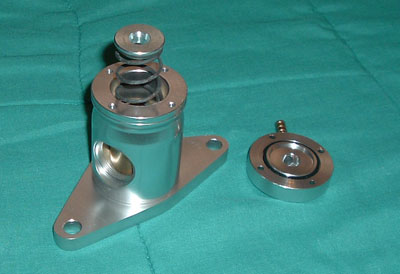
How to Adjust your Aftermarket BOV
Remember, the only factor that you can really change is SPRING ENERGY. There are several ways to do this. Less spring energy means your BOV piston will open easily. More spring energy means it will be harder to open and more resistant to opening during high-vacuum conditions. Your goal is to have the lowest amount of spring energy that keeps your BOV closed during high-vacuum conditions.
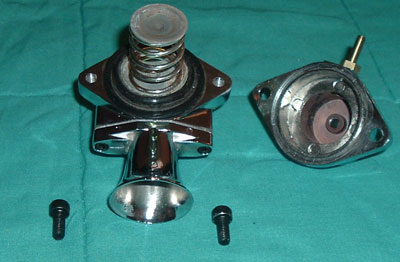
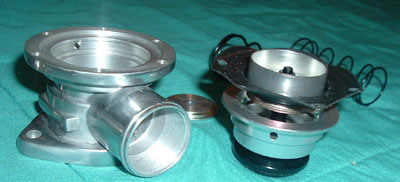
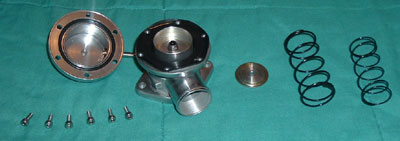
BOV Myth #3: The easiest way to get my turbo car to make a cool "PSSSHHHH" sound is to get a BOV that vents to atmosphere.
On many cars, the air is metered by a device called a MAS/MAF before the turbo inlet. If this is the case on your car, venting your BOV to the atmosphere can result in an inaccurate count of the air entering your engine, resulting in a rich condition after each shift, damaging performance. On some cars it won't be noticeable, but on some cars it will cause the engine to stall instantly. On all cars with pre-turbo MAF/MAS, it is officially "incorrect".
If this is the air metering method in your car and you want the "PSSSHHHH" noise, you would be better off installing an open-element air filter, since it is the airbox on most cars that stifles the blow off noise.
If this does not give you the desired effect, you might try changing your BOV to one of our aftermarket BOV's that is capable of recirculating to the turbo inlet pipe.
Interesting note: The only technical difference between a BOV and a CBV (compressor bypass valve) is that a CBV recirculates. If you are recirculating, it is technically correct to call it a CBV not a BOV, although the industry has made the terms synonymous.
Theoretically, you can actually hold more boost if you are not recirculating. When you recirculate, the BOV outlet recirculates into the pre-turbo intake pipe. During acceleration, the pre-turbo intake pipe is under vacuum. This can subject the top or side of the BOV/CBV piston to vacuum on some BOVs, trying to pull it open. This is what causes some BOVs to leak at lower boost than our website recommends them for.
BOV Myth #4: You need a really great BOV to run really high boost.
There is an aspect of truth to this, however a BOV is a very simple product once you understand it and all of them work pretty much the same way.
Our website has recommended boost levels listed for each of our BOVs. However we feel that the numbers are VERY conservative and we have personally tested some of them to 60 PSI with no boost leaks.
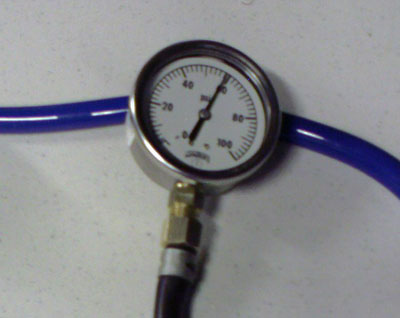
The typical point of failure on a BOV is the membrane that allows the piston to move. Either it will leak at the seal or it will rupture causing the BOV to always leak under boost. We take this point of failure into consideration when recommending boost levels for our BOVs.
Another cause of BOV leakage is the seal at the bottom of the piston. This is a temporary seal that has to break instantly and easily during pressure release yet be strong enough when closed to prevent boost leakage. We also take this point of failure into consideration when recommending boost levels for our BOVs.
One thing that is important is the issue of BOV volume. The goal of a BOV is to release the pressure on the turbo as rapidly as possible, and a BOV with a 0.5 inch inlet would not be ideal for a 30 PSI car. Think of it as drilling an instant, temporary hole in your intake piping. A bigger hole will release the pressure much more rapidly.
Get a high quality aftermarket BOV from us and follow our recommendations for selecting and installing it and you will get years of trouble free operation at an unbeatable price.
THE VIEWS AND IDEAS EXPRESSED IN THIS ARTICLE ARE SUPPORTED TECHNICAL HYPOTHESES NOT SCIENTIFIC FACT - USE AT YOUR OWN RISK.
This is a well researched article based on the following sources:

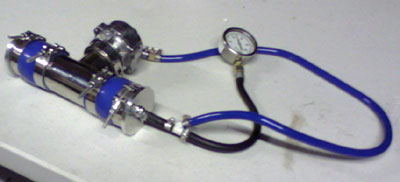
Here are some resources that we used during research. The sources listed here support some or all of our ideas. Some of them conflict with other ideas. All of them have a counterpart somewhere on the internet that they conflict with.
http://www.935motorsports.com/greddybov.htm
http://wwwrsphysse.anu.edu.au/~amh110/blow_off_valve.htm
http://forums.evolutionm.net/showthr...&highlight=bov
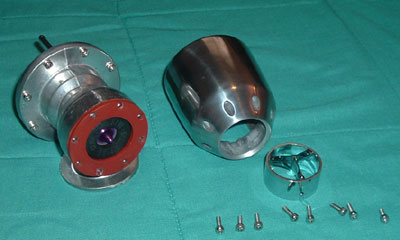
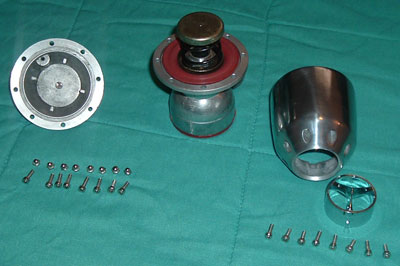
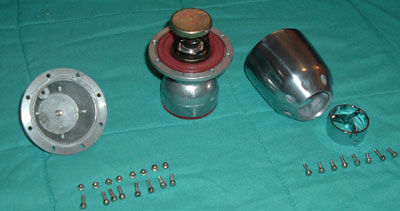
This is the most dangerous myth of all. If you hear a different sound from adjusting this screw, it means you are getting compressor surge which could destroy your turbo.
All this screw does is adjust the preload on your BOV spring. BOV's have a small metal plate on top of the spring. The screw screws directly into this plate, compressing the spring. Tightening it (turning it right/in) will compress the spring, increasing the spring energy. Loosening it (turning it left/out) will decompress the spring, lowering the spring energy. (Side note: you can achieve the exact same effect by placing washers/shims on top of the BOV spring.) As you will read below, the BOV spring should be adjusted to the lightest level possible while still holding your BOV shut during high vacuum conditions.
BOV Myth #2: The spring in a BOV holds the BOV closed during moments of high boost.
First thing is first: The purpose of the spring in a BOV IS NOT to hold your BOV closed under boost pressure! Selecting a spring based on PSI is incredibly confusing/meaningless and it makes us wonder if the people who pioneered aftermarket BOV design in the first place even understood how they work.
All BOVs have a reference line coming into the top of the BOV from your post-throttle body intake manifold. Under high boost, the force holding the BOV closed is BOOST! The pressure coming through the reference line is equal to the pressure under the BOV piston. Therefore a VERY mild spring will hold it shut just fine under these conditions.
Rather, the purpose of the spring in a BOV is to hold the BOV closed when your throttle plate is closed, IE during idle and deceleration conditions. Under these conditions, the vacuum in your intake manifold is much higher than the vacuum in your intake piping (therefore under the BOV piston) so the BOV has a natural tendency to spring open. Being open isn't even a problem if you are recirculating your BOV into your intake, however if you are NOT recirculating, it can allow unfiltered air into your intake which IS a problem.
Therefore, your goal when selecting a BOV spring and adjusting the BOV should NOT be to select a spring based on your boost level; that makes no sense. Your goal is to get the BOV to stay CLOSED during high intake manifold vacuum/closed throttle plate conditions, using the very smallest amount of spring energy possible. Using less spring energy will allow the BOV to snap open as rapidly as possible when pressure release is necessary.
How to Adjust your Aftermarket BOV
Remember, the only factor that you can really change is SPRING ENERGY. There are several ways to do this. Less spring energy means your BOV piston will open easily. More spring energy means it will be harder to open and more resistant to opening during high-vacuum conditions. Your goal is to have the lowest amount of spring energy that keeps your BOV closed during high-vacuum conditions.
- [*]
BOV Myth #3: The easiest way to get my turbo car to make a cool "PSSSHHHH" sound is to get a BOV that vents to atmosphere.
On many cars, the air is metered by a device called a MAS/MAF before the turbo inlet. If this is the case on your car, venting your BOV to the atmosphere can result in an inaccurate count of the air entering your engine, resulting in a rich condition after each shift, damaging performance. On some cars it won't be noticeable, but on some cars it will cause the engine to stall instantly. On all cars with pre-turbo MAF/MAS, it is officially "incorrect".
If this is the air metering method in your car and you want the "PSSSHHHH" noise, you would be better off installing an open-element air filter, since it is the airbox on most cars that stifles the blow off noise.
If this does not give you the desired effect, you might try changing your BOV to one of our aftermarket BOV's that is capable of recirculating to the turbo inlet pipe.
Interesting note: The only technical difference between a BOV and a CBV (compressor bypass valve) is that a CBV recirculates. If you are recirculating, it is technically correct to call it a CBV not a BOV, although the industry has made the terms synonymous.
Theoretically, you can actually hold more boost if you are not recirculating. When you recirculate, the BOV outlet recirculates into the pre-turbo intake pipe. During acceleration, the pre-turbo intake pipe is under vacuum. This can subject the top or side of the BOV/CBV piston to vacuum on some BOVs, trying to pull it open. This is what causes some BOVs to leak at lower boost than our website recommends them for.
BOV Myth #4: You need a really great BOV to run really high boost.
There is an aspect of truth to this, however a BOV is a very simple product once you understand it and all of them work pretty much the same way.
Our website has recommended boost levels listed for each of our BOVs. However we feel that the numbers are VERY conservative and we have personally tested some of them to 60 PSI with no boost leaks.
The typical point of failure on a BOV is the membrane that allows the piston to move. Either it will leak at the seal or it will rupture causing the BOV to always leak under boost. We take this point of failure into consideration when recommending boost levels for our BOVs.
Another cause of BOV leakage is the seal at the bottom of the piston. This is a temporary seal that has to break instantly and easily during pressure release yet be strong enough when closed to prevent boost leakage. We also take this point of failure into consideration when recommending boost levels for our BOVs.
One thing that is important is the issue of BOV volume. The goal of a BOV is to release the pressure on the turbo as rapidly as possible, and a BOV with a 0.5 inch inlet would not be ideal for a 30 PSI car. Think of it as drilling an instant, temporary hole in your intake piping. A bigger hole will release the pressure much more rapidly.
Get a high quality aftermarket BOV from us and follow our recommendations for selecting and installing it and you will get years of trouble free operation at an unbeatable price.
THE VIEWS AND IDEAS EXPRESSED IN THIS ARTICLE ARE SUPPORTED TECHNICAL HYPOTHESES NOT SCIENTIFIC FACT - USE AT YOUR OWN RISK.
This is a well researched article based on the following sources:
- [*]
- Significant bench testing of BOV behavior using an air compressor and pressure relief valves.
- On-car testing of 3 different BOV's at boost levels ranging from 14 to 26 PSI
Here are some resources that we used during research. The sources listed here support some or all of our ideas. Some of them conflict with other ideas. All of them have a counterpart somewhere on the internet that they conflict with.
http://www.935motorsports.com/greddybov.htm
http://wwwrsphysse.anu.edu.au/~amh110/blow_off_valve.htm
http://forums.evolutionm.net/showthr...&highlight=bov
Thread
Thread Starter
Forum
Replies
Last Post
m.e.greene
Honda Accord Forum
2
08-24-2019 02:36 PM
Sporttuners
PRIVATE For Sale / Trade Classifieds
0
07-06-2013 10:29 PM




